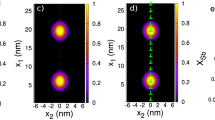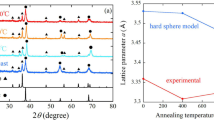Abstract
A comparative study of high-temperature oxidation of Ni containing 1 at.% Cr and pure Ni was carried out. Instead of the conventional kinetics study using thermogravimetry, a microlithographic marker experiment was designed. Observation of the markers using cross-sectional TEM and SEM has revealed striking differences in the scale morphology, microstructures, and oxidation mechanisms between pure Ni and the Cr-doped Ni substrates. In particular, the results suggest that a small addition of Cr promotes significant inward transport of oxygen. Marker experiments revealed that NiO grown on pure Ni is wholly attributable to outward-cation diffusion. In contrast, NiO grown on Ni−1 at.% Cr exhibited formation of a substantial inner layer having a submicron grain size, established by the markers to have formed from oxygen ingress. For pure Ni, voids were observed to be distributed only within oxide grains. In contrast, for Ni containing 1 at.% Cr, elongated pores formed extensively along oxide-grain boundaries. Formation of new fine-grain oxide in these pores was observed to have sometimes completely resealed the void. It is, therefore, proposed that the transport of oxygen in the case of oxide scale grown on Ni−1 at.% Cr occurs via voids (pores) formed by vacancy coalescence at the grain boundaries.
Similar content being viewed by others
References
S. Mrowec,Corros. Sci. 7, 563 (1967).
G. B. Gibbs and R. Hales,Corros. Sci. 17, 487 (1977).
G. J. Yurek and H. Schmalzried,Ber. Bunsen-Ges. Phys. Chem. 79, 255 (1975).
D. P. Moon, A. W. Harris, P. R. Chalker, and S. Mountfort,Mater. Sci. Technol. 4, 1101 (1988).
D. P. Moon,Oxid. Met. 31, 71 (1989).
A. Atkinson and D. W. Smart,J. Electrochem. Soc. 135, 2886 (1988).
A. Atkinson, UKAEA Harwell ReportAERE-R12404 (1987).
A. W. Harris and A. Atkinson, UKAEA Harwell ReportAERE-R13421 (1989).
A. Atkinson,Mater. Sci. Technol. 4, 1046 (1988).
A. Atkinson and D. W. Smart, UKAEA Harwell ReportAERE-R12762 (1987).
H. V. Atkinson,Mater. Sci. Technol. 4, 1052 (1988).
J. Robertson and M. I. Manning,Mater. Sci. Technol. 4, 1064 (1988).
A. G. Evans, D. Rajdev, and D. L. Douglass,Oxid. Met. 4, 151 (1972).
P. Kofstad,Oxid. Met. 24, 265 (1985).
R. B. Marcus and T. T. Sheng,Transmission Electron Microscopy of Silicon VLSI Circuits and Structures (Wiley, New York, 1983), p. 19.
C. K. Kim, S. K. Fan, and L. W. Hobbs, inMicroscopy of Oxidation, G. J. Lorimer, ed. (Institute of Metals, 1991), p. 374.
B. L. Gleeson, D. L. Douglass and F. Gesmundo,Oxid. Met. 31, 209 (1989).
E. M. Fryt, G. C. Wood, F. H. Stott and D. P. Whittle,Oxid. Met. 23, 77 (1985).
H. M. Hindam and W. W. Smeltzer,Oxid. Met. 14, 337 (1980).
C. M. Cotell, K. Przybylski, and G. J. Yurek, inFundamental Aspects of High Temperature Corrosion, Vol. 2, D. A. Shores and G. J. Yurek eds. (The Electrochemical Society, Pennington, NJ, 1986), p. 103.
E. W. A. Young, H. E. Bishop and J. H. de Wit,Surf. Interface Anal. 9, 163 (1986).
T. A. Ramanarayanan, R. Ayer, R. Petkovic-Luton, and D. P. Leta,Oxid. Met. 29, 445 (1988).
F. H. Stott, I. G. Wright, T. Hodgkiess, and G. C. Wood,Oxid. Met. 11, 141 (1977).
L. W. Hobbs and T. E. Mitchell, inHigh Temperature Corrosion, R. A. Rapp, ed. (NACE-6, Houston, 1983), p. 76.
P. Kofstad,JIMIS-3 Suppl., 1 (1983).
A. Atkinson and R. I. Taylor, UKAEA Harwell ReportAERE-R11763 (1985).
A. Atkinson, D. W. Smart, and R. I. Taylor, UKAEA Harwell ReportAERE-R12751 (1987).
P. Choquet and R. Mevrel,Mater. Sci. Eng. A120, 153 (1989).
C. H. Yang, G. E. Welsch, and T. E. Mitchell,Mater. Sci. Eng. 69, 351 (1985).
J. Stringer,Corros. Sci. 10, 513 (1970).
A. G. Evans and R. M. Cannon,Mater. Sci. Forum 43, 243 (1989).
B. A. Pint, J. R. Martin, and L. W. Hobbs,Oxid. Met. 39, 167 (1993).
B. A. Pint and L. W. Hobbs,Oxid. Met. 41, 203 (1994).
Author information
Authors and Affiliations
Rights and permissions
About this article
Cite this article
Kim, C.K., Hobbs, L.W. Microstructural evidence for short-circuit oxygen diffusion paths in the oxidation of a dilute Ni-Cr alloy. Oxid Met 45, 247–265 (1996). https://doi.org/10.1007/BF01046984
Received:
Revised:
Issue Date:
DOI: https://doi.org/10.1007/BF01046984




